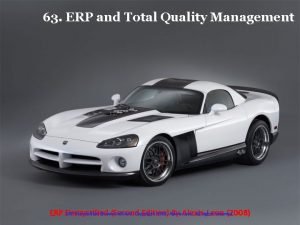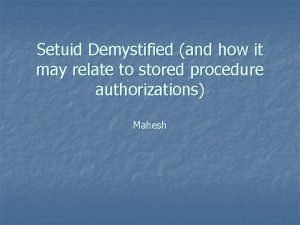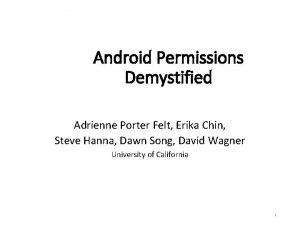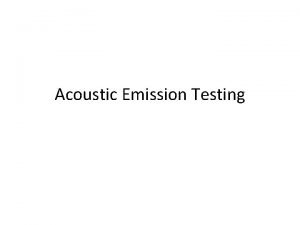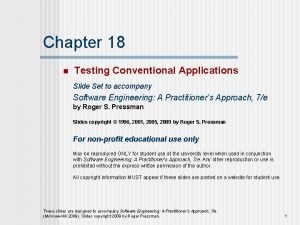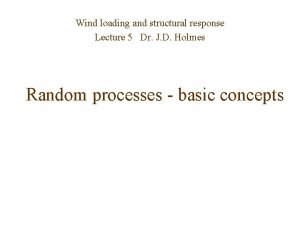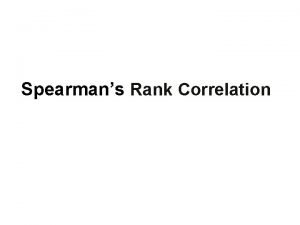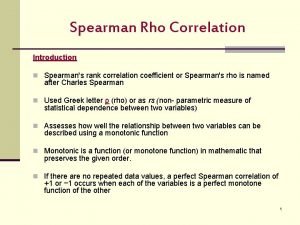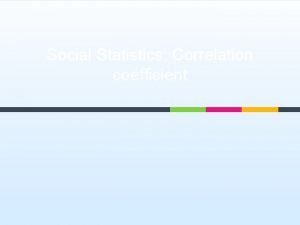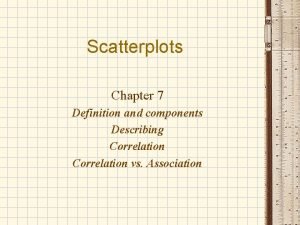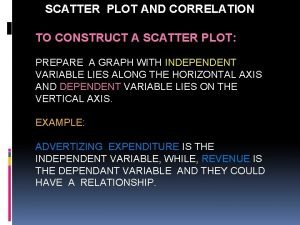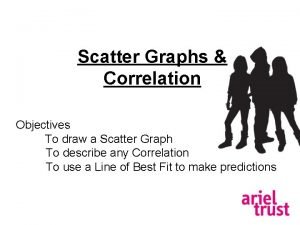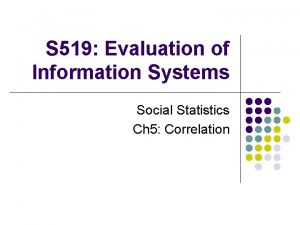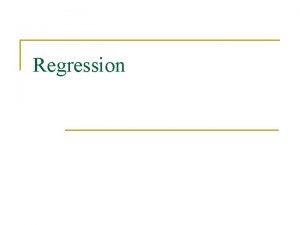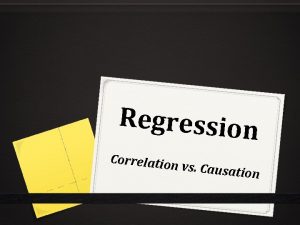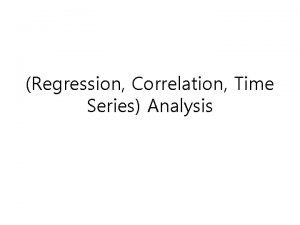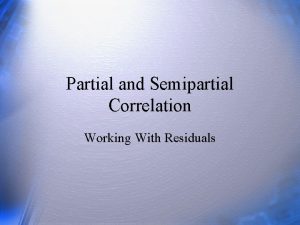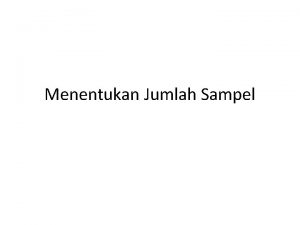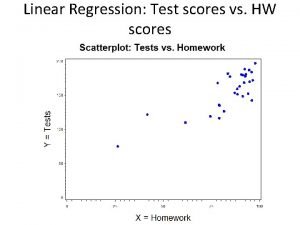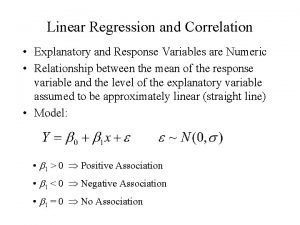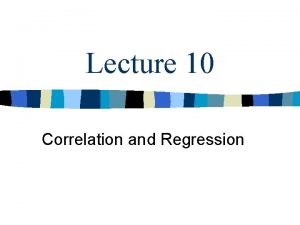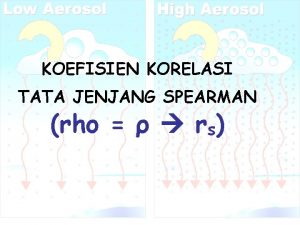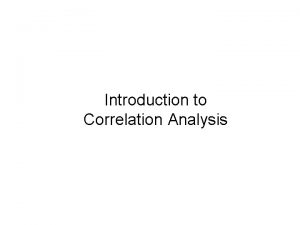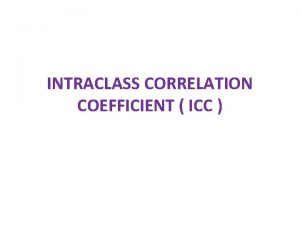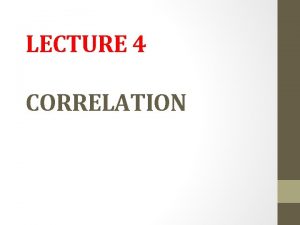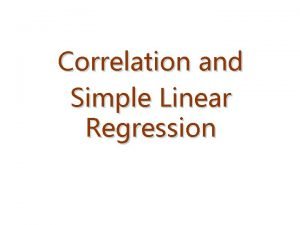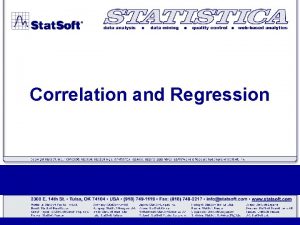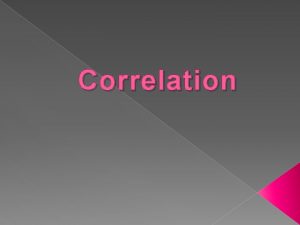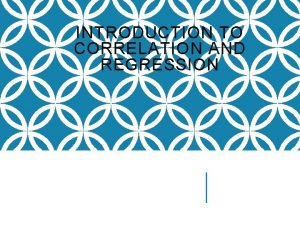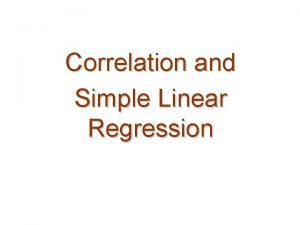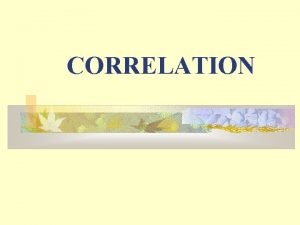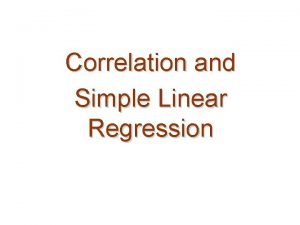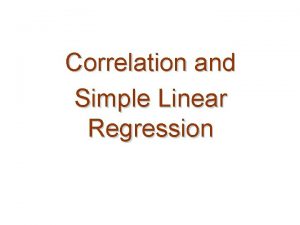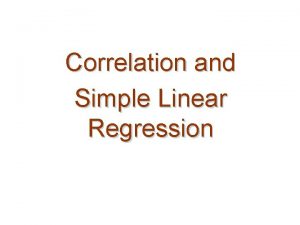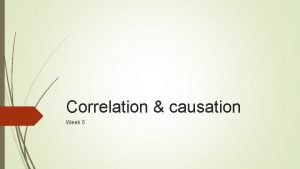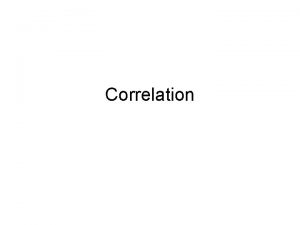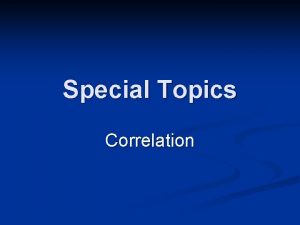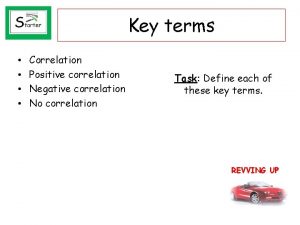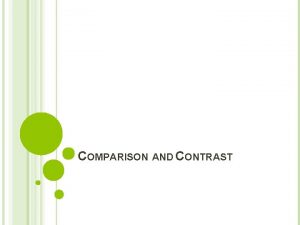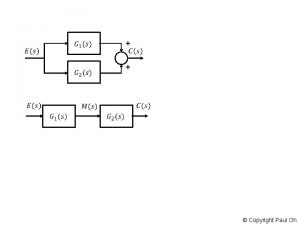Comparison Testing Demystified Applications of Correlation Testing PAUL




























































- Slides: 60

Comparison Testing Demystified: Applications of Correlation Testing PAUL RICHARDSON. MSC, FIBMS. SENIOR HPTN QA/QC COORDINATOR PRICHA 18@JHMI. EDU

ACKNOWLEDGEMENTS • Sponsored by NIAID, NIDA, NIMH under Cooperative Agreement # UM 1 AI 068619

Comparison Testing Demystified Paul Richardson. • Why do we need to perform comparison testing? Mark Swartz. • How do we perform correlation testing? Anne Sholander. • Applications of correlation testing as an alternate to commercial EQA.

Objectives After this presentation you should be able to: • • • Define correlation testing Explain why correlation is necessary Explain when correlation testing is required Define the recommended frequency of correlation Explain how to develop acceptability criteria for correlation • Troubleshoot failed correlation • Explain applications for correlation testing as an alternative to commercial EQA panels

Definition of Correlation: An examination using mathematical or statistical variables of two or more items to establish similarities and dissimilarities.

Comparison Testing Why do we perform comparison testing

Is it because the guidelines tell us to? DAIDS Guidelines for Good Clinical Laboratory Practice Standards NO Final Version 2. 0, 25 July 2011

Is it because the guidelines tell us to? Parallel testing is discussed but only in terms of new reagent lots. Do not have time to discuss parallel testing here

Is it because the guidelines tell us to? But the DAIDS Audit Shell does ask: Is there a back-up method for each assay ? Are there periodic comparison checks between the primary and back-up methods?

Comparison Testing If it isn't in the guidelines, why do we perform comparison testing

Comparison Testing Because it is good practice Because stuff happens and you may need to use a different lab or method

Comparison Testing Trafford General Hospital. UK 5 th July 1929

Comparison Testing Pathology Lab – Spring Morning 1993

Parallel testing : Back-up comparison Unexpected staffing problems

Comparison Testing Broken Lab equipment

Comparison Testing Delivery problem

Comparison Testing May fail QA checks such as parallel testing Old Reagent 152 73 487 298 New Delivery 19 21 794 112

Parallel testing : Back-up comparison Proficiency Testing Problems

Comparison Testing Need to look for an alternate method

Comparison Testing Similar instrument within the same laboratory

Comparison Testing Alternate methodology in an external laboratory

Comparison Testing Back-up comparison Study-participant specimens tested often to assess comparability of results on a regular basis.

Documentation Remember GCLP Training: If it isn't documented, it never happened.

Documentation Guidelines state labs should retain: • Instrument printouts • QC records -comparison is a QC record • Pack inserts • Certificates of Analysis

Documentation Ensure that the details of your comparison testing are well described in your Quality Manual and site SOPs

Documentation SOP Should Include: • What to use for comparison testing • When to perform • Acceptability criteria • How to document acceptability and failures • What to do if comparison passes • What to do if comparison fails • Supervisory review process

Comparison Testing So how do we perform correlation testing

Comparison Testing Demystified: Applications of Correlation Te Mark Swartz, MT(ASCP), International QA/QC Coordinator, SMILE mswartz 4@jhmi. edu Anne Sholander, MT(ASCP), International QA/QC Coordinator, SMILE asholan 2@jhmi. edu

www. psmile. org 29

Acknowledgements The presenters would like to thank: DAIDS -Daniella Livnat and Mike Ussery This project has been funded in whole or in part with Federal funds from the Division of AIDS (DAIDS), National Institute of Allergy and Infectious Diseases, National Institutes of Health, Department of Health and Human Services, under contract No. HHSN 266200500001 C, titled Patient Safety Monitoring in International Laboratories. IMPAACT Network HPTN - Paul Richardson Johns Hopkins University - SMILE Dr. Robert Miller - Principal Investigator Barbara Parsons - Operation Manager Kurt Michael - Project Manager Jo Shim, Mandana Godard & SMILE Staff 30

What are we correlating? §Primary Instrument § Successful EQA performance history §Backup instrument § Same room? § Same facility? § Clinic? § Different lab? §Same make and manufacturer? § Specificity for the analyte §Same reference ranges? 31

Samples § Fresh patient samples are ideal § Stored patient samples are next to ideal § How is sample integrity affected by storage? § Pooled samples – Ag/Ab reactions might cause protein precipitation 32

Samples §Ideally QC, EQA, linearity, and other standards should not be used §Matrix, especially between different instrument makes or models, may mask “true difference” of results §Designed for one platform (calibrators/QC) 33

Samples § However, it may be necessary to use QC, EQA, linearity, and other standards § Lack of patient samples § An attempt should be made to span analytical measurement range § Volatility of the analyte correlated (storage and transport) § Manufacturer designed materials specifically for validation/correlation 34

How many? How often? § No requirements. However, considerations must be made… § Type I vs Type II error § Type I – detecting an insignificant error § Type II – not detecting a significant error § An attempt should be made to cover measurement range § Ability to acquire proper specimens § Availability of reagents § Time spent procuring, storing, transporting, measuring samples and evaluating results 35

Special Instances §Failure of periodic monitoring of comparison testing §EQA Failure §Internal Quality Control result failure §Reagent or calibrator lot change §Major instrument maintenance §Clinician inquiry regarding the accuracy of results 36

Getting ready… § Preparing instrumentation § All maintenance up to date? § Quality Controls within range? Any bias? § Store samples for the same amount of time, Run on both instruments at the same time 37

How NOT to evaluate your data How not to Evaluate Your Data…… Instr. 1 Instr. 2 Δ Sample 1 6000. 0 60 5940. 0 Sample 2 7000. 0 70 6930. 0 Sample 3 8000. 0 80 7920. 0 Sample 4 9000. 0 90 8910. 0 Sample 5 10000. 0 100 9900. 0 Correlation Coefficient (r) = 1. 00 38

Glucose Instr. 1 Replicate 1 2 Instr. 2 Mean Replicate 1 2 Mean Sample 1 92 93 92. 5 91 87 89 Sample 2 58 59 58. 5 58 57 57. 5 Sample 3 136 137 136. 5 130 127 128. 7 Sample 4 302 303 302. 5 278 275 276. 5 Sample 5 214 214. 5 209 205 207 39

Glucose Sample 1 Instr. 1 Replicate 1 2 92 93 Instr. 2 Mean 92. 5 Replicate 1 2 91 87 Mean 89 Grand Mean = (92. 5 + 89)/2 = 90. 75 Difference (Δ)= 92. 5 - 89= 3. 5 % Difference = 3. 5/90. 75 x 100 = 3. 85% 40

Guidelines for Grading Criteria §Recommendations based on clinical studies §Recommendations from clinicians at your institution §Recommendations based on biological variability §Minimum requirements set by accreditation agency §EQA criteria §Capability of the instrument based on internal imprecision data 41

Cumulative Statistics CLIA Total Allowable Error = 10% 42

Glucose Instr. 1 Replicate 1 2 Sample 1 92 93 Instr. 2 Mean 92. 5 Replicate 1 2 91 87 Mean 89 Grand Mean = (92. 5 + 89)/2 = 90. 75 Difference (Δ)= 92. 5 - 89= 3. 5 % Difference = 3. 5/90. 75 = 3. 85% 43

Critical Difference 44

Evaluation % Difference (3. 85%) = 1. 54 Cumulative CV (2. 5%) This ratio measures the % Difference as a multiple of the Cumulative CV of the worst performing instrument. 45

Documentation Accept. %Diff/CV Pass/ % Diff/CV ratio Fail Ratio Analyte Instr. 1 Mean Instr. 2 Mean Grand Mean Δ %Δ Cume CV Glucose 92. 5 89 90. 75 3. 9 2. 5 1. 5 ≤ 3 PASS Glucose 58. 5 57. 5 58 1 1. 7 2. 5 0. 7 ≤ 3 PASS Glucose 136. 5 128. 7 132. 6 7. 8 5. 9 2. 5 2. 4 ≤ 3 PASS Glucose 302. 5 276. 5 289. 5 26 9. 0 2. 2 3. 6 ≤ 3 FAIL Glucose 214. 5 207 210. 75 7. 5 3. 6 2. 2 1. 4 ≤ 3 PASS 46

Troubleshooting §Different methodologies §Difference in calibration §Difference in imprecision §Difference in reagent lot or shipment (storage) 47

Troubleshooting cont. §Difference in lot of calibrators or assignment of values §Difference in age of calibrators (date opened) §Difference in reagent life on instrument §Difference in instrument parameters (dilution ratios, incubation times, etc. ) 48

49

Correlation as an Alternative to Commercial EQA Panels How can correlation testing be used to EQA multiple methods, locations, clinics? What are the CAP, CLIA, GCLP requirements for EQA of each method? What are the advantages and disadvantages of using correlation to satisfy these requirements 50

Some Schemes Currently in Use Reference or Central Lab Shared EQA Panels Parent-Clinic Model 51

EQA Panels Made by a Reference Lab A Reference or Central Lab HPTN Network Lab IMPAACT Central Lab B Lab C 52

How are the results evaluated? Correlation Between the reference lab and the local lab Evaluation Challenges Using SMILE evaluation criteria Methods must be (composite of CLIA, similar CAP and Accutest) Lack of peer group Realistic only for qualitative samples 53

Commercial EQA Shared EQA Panels Instrument 1 or Clinic 1 Instrument 2 or Clinic 2 Instrument 3 or Clinic 3 54

How are the results evaluated? Correlation Between the local lab and the peer data collected by EQA provider Evaluation EQA provider’s criteria Challenges Adequate sample volume CLIA TEa criteria 55

Parent-Clinic Model Parent Lab Clinic 1 Clinic 2 Clinic 3 Must be participating in commercial EQA Clinic 4 56

How are the results evaluated? Correlation Between the main (parent) lab and clinics Evaluation Challenges Acceptability criteria set by the main lab Finding appropriate SMILE suggests using samples historical CV or 50% Stability of samples of CLIA (quantitative) 57

In Conclusion…. Define correlation testing Explain why correlation is necessary Explain when correlation testing is required Define the recommended frequency of correlation • Explain how to develop acceptability criteria for correlation • Troubleshoot failed correlation • Explain applications for correlation testing as an alternative to commercial EQA panels • • 58

Questions Paul Richardson, HPTN pricha 18@jhmi. edu Mark Swartz, SMILE mswartz 4@jhmi. edu Anne Sholander, SMILE asholan 2@jhmi. edu

References 1. Clinical and Laboratory Standards Institute. (2008). Verification of Comparability of Patient Results Within One Health Care System: Approved Guideline. Wayne, PA, USA: CLSI; CLSI document C 54 -A. 2. Clinical and Laboratory Standards Institute. (2008). Assessment of Laboratory Tests When Proficiency Testing is Not Available: Approved Guideline. (2 nd ed. ). Wayne, PA, USA: CLSI; CLSI document GP 20 -A 2. 3. Core Chemistry Quality Control Plan, Johns Hopkins University, Department of Pathology, Core/Specialty Laboratories, June 21, 2011. 4. College of American Pathologists CAP Accreditation Program All Common Checklist 2012. 5. Fraser, C. G (2001). Biological Variation: From Principles to Practice. Washington, DC: AACC Press. 6. Guidelines for Use of Back-Up Equipment and Back-Up Clinical Laboratories in DAIDS-Sponsored Clinical Trials Networks Outside the USA, Backup Lab Guidelines v. 2. 0 2010 -11 -10, HIV/AIDS Network Coordination (HANC). 7. National Institute of Health. (2011). DAIDS Guidelines for Good Clinical Laboratory Practice Standards. Bethesda, Maryland. 60
 Positive correlation versus negative correlation
Positive correlation versus negative correlation No correlation gif
No correlation gif Total quality management in erp
Total quality management in erp Erp demystified
Erp demystified Setuid demystified
Setuid demystified Erp demystified
Erp demystified Adrienne porter felt
Adrienne porter felt Limit comparison test
Limit comparison test Ultrasonic inspection machine
Ultrasonic inspection machine Mobile performance testing using loadrunner
Mobile performance testing using loadrunner Testing conventional applications in software engineering
Testing conventional applications in software engineering Acoustic emission testing applications
Acoustic emission testing applications Testing soa applications
Testing soa applications Testing conventional applications in software engineering
Testing conventional applications in software engineering What is domain test
What is domain test Motivational overview of logic based testing
Motivational overview of logic based testing Data flow testing strategies in software testing
Data flow testing strategies in software testing Positive and negative testing
Positive and negative testing Static testing and dynamic testing
Static testing and dynamic testing Globalization testing example
Globalization testing example Neighborhood integration testing
Neighborhood integration testing Language testing
Language testing Control structure testing in software engineering
Control structure testing in software engineering Decision table testing in software testing
Decision table testing in software testing Decision table testing
Decision table testing Pengertian black box
Pengertian black box Behavioral testing adalah
Behavioral testing adalah Decision table testing
Decision table testing Rigorous testing in software testing
Rigorous testing in software testing Testing blindness in software testing
Testing blindness in software testing Component testing is a black box testing
Component testing is a black box testing Software testing domains
Software testing domains Load response correlation
Load response correlation Uji korelasi spearman rho
Uji korelasi spearman rho Beggs and brill correlation
Beggs and brill correlation P value pearson correlation
P value pearson correlation Eq and iq correlation
Eq and iq correlation Example of positive correlation in psychology
Example of positive correlation in psychology Relationship between pressure and volume direct or indirect
Relationship between pressure and volume direct or indirect Trc reading levels
Trc reading levels What is the fbi
What is the fbi Spearman correlation calculator
Spearman correlation calculator T-test for correlation coefficient
T-test for correlation coefficient Scatterplots definition
Scatterplots definition Correlation in scatter diagram
Correlation in scatter diagram Negative correlation scatter plot
Negative correlation scatter plot Correlation vs association
Correlation vs association Difference between regression and correlation
Difference between regression and correlation Correlation vs causation
Correlation vs causation Durbin watson test interpretation
Durbin watson test interpretation Semi partial correlation r
Semi partial correlation r Fossil correlation continental drift
Fossil correlation continental drift Rote understanding application correlation
Rote understanding application correlation Minimum sample for correlation
Minimum sample for correlation Correlation hypothesis example
Correlation hypothesis example Explanatory variable and response variable
Explanatory variable and response variable Correlation hypothesis example
Correlation hypothesis example Tabel nilai rho
Tabel nilai rho Objectives of correlation
Objectives of correlation Intraclass correlation coefficient
Intraclass correlation coefficient Discrete and continuous examples
Discrete and continuous examples


